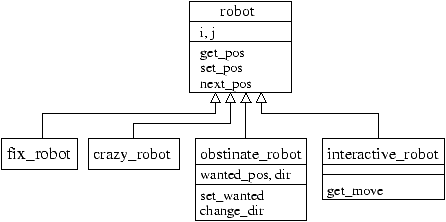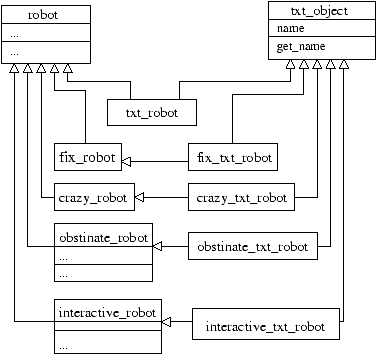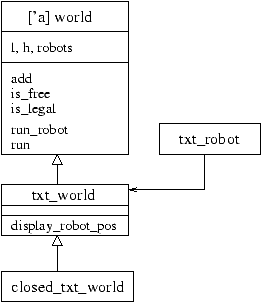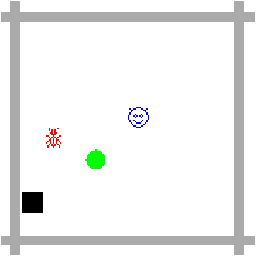


Fancy Robots
The example in this section illustrates the use of objects from the
graphics library. We will revisit the concepts of simple
inheritance, overriding methods and dynamic dispatch. We also
see how parametric classes may be profitably used.
The application recognizes two principal categories of objects: a
world and robots. The world represents a state space within which
the robots evolve. We will have various classes of robots, each
possessing its own strategy to move around in the world.
The principle of interaction between robots and the world here is
extremely simple. The world is completely in control of the game: it
asks, turn by turn, each of the robots if they know their next
position. Each robot determines its next position fairly blindly. They
do not know the geometry of the world, nor what other robots may be
present. If the position requested by a robot is legal and open, the
world will place the robot at that position.
The world displays the evolution of the robots via an interface.
The (relative) complexity of the conception and development of this
example is in the always-necessary separation between a behavior
(here the evolution of the robots) and its interface (here the
tracking of this evolution).
General Description
The application is developed in two stages.
- A group of definitions providing pure calculation classes for
the world and for the diverse set of envisaged robots.
- A group of definitions using the preceding set, adding whatever
is necessary to add in an interface.
We provide two examples of such interfaces: a rudimentary text-based
interface, and a more elaborate one using a graphical library.
In the first section, we provide the abstract definitions for
the robots. Then (page ??), we provide the pure abstract
definition for the world. In the next section (page ??), we introduce the
text interface for the robots, and in the fourth section (page ??), the interface for
the world. On page ?? we introduce a graphical interface
for the robots and finally (page ??) we define a world for the
graphical interface.
``Abstract'' Robots
The first thing to do is to examine robots abstractly, independent of
any consideration of the environment in which they will move, that is
to say, the interface that displays them.
# class virtual robot (i0:int) (j0:int) =
object
val mutable i = i0
val mutable j = j0
method get_pos = (i,j)
method set_pos (i', j') = i <- i'; j <- j'
method virtual next_pos : unit -> (int * int)
end ;;
A robot is an entity which knows, or believes it knows, its position
(i and j), is capable of communicating that position
to a requester (get_pos), is able to modify this knowledge
if it knows precisely where it should be (set_pos) and may
decide to move towards a new position (next_pos).

Figure 17.9: Hierarchy of pure robot classes
To improve the readability of the program, we define relative
movements based on absolute directions:
# type dir = North | East | South | West | Nothing ;;
# let walk (x,y) = function
North -> (x,y+1) | South -> (x,y-1)
| West -> (x-1,y) | East -> (x+1,y)
| Nothing -> (x,y) ;;
val walk : int * int -> dir -> int * int = <fun>
# let turn_right = function
North -> East | East -> South | South -> West | West -> North | x -> x ;;
val turn_right : dir -> dir = <fun>
The schema is shown by the virtual class robots from which we
define four distinct species of robots (see figure
17.9) to more precisely see their manner of motion:
-
Fixed robots which never move:
# class fix_robot i0 j0 =
object
inherit robot i0 j0
method next_pos() = (i,j)
end ;;
- Crazy robots which move at random:
# class crazy_robot i0 j0 =
object
inherit robot i0 j0
method next_pos () = ( i+(Random.int 3)-1 , j+(Random.int 3)-1 )
end ;;
- Obstinate robots which keep trying to advance in one direction
whenever they are able to do so,
# class obstinate_robot i0 j0 =
object(self)
inherit robot i0 j0
val mutable wanted_pos = (i0,j0)
val mutable dir = West
method private set_wanted_pos d = wanted_pos <- walk (i,j) d
method private change_dir = dir <- turn_right dir
method next_pos () = if (i,j) = wanted_pos
then let np = walk (i,j) dir in ( wanted_pos <- np ; np )
else ( self#change_dir ; wanted_pos <- (i,j) ; (i,j) )
end ;;
- Interactive robots which obey the commands of an exterior operator:
# class virtual interactive_robot i0 j0 =
object(self)
inherit robot i0 j0
method virtual private get_move : unit -> dir
method next_pos () = walk (i,j) (self#get_move ())
end ;;
The case of the interactive robot is different from the others in that
its behavior is controlled by an interface that permits communicating
orders to it. To deal with this, we provide a virtual method to
communicate this order. As a consequence, the class
interactive_robot remains abstract.
Note that not only do the four specialized robot classes inherit from
class robot, but also any others that have the same type.
In effect, the only methods that we have added are the private methods
that therefore do not appear in the type signatures of the instances of
these classes (see page ??). This
property is indispensable if we wish to consider all the robots to be
objects of the same type.
Pure World
A pure world is a world that is independent of an interface. It
is understood as the state space of positions which a robot may
occupy. It takes the form of a grid of size l ×
h, with a method is_legal to assure that a
coordinate is a valid position in the world, and a method
is_free indicates whether or not a robot occupies a given
position.
In practice, a world manages the list of robots present on its surface
while a method, add, allows new robots to enter the world.
Finally, a world is made visible by the method run, allowing
the world to come to life.
# class virtual ['robot_type] world (l0:int) (h0:int) =
object(self)
val l = l0
val h = h0
val mutable robots = ( [] : 'robot_type list )
method add r = robots <- r::robots
method is_free p = List.for_all (fun r -> r#get_pos <> p) robots
method virtual is_legal : (int * int) -> bool
method private run_robot r =
let p = r#next_pos ()
in if (self#is_legal p) & (self#is_free p) then r#set_pos p
method run () =
while true do List.iter (function r -> self#run_robot r) robots done
end ;;
class virtual ['a] world :
int ->
int ->
object
constraint 'a =
< get_pos : int * int; next_pos : unit -> int * int;
set_pos : int * int -> unit; .. >
val h : int
val l : int
val mutable robots : 'a list
method add : 'a -> unit
method is_free : int * int -> bool
method virtual is_legal : int * int -> bool
method run : unit -> unit
method private run_robot : 'a -> unit
end
The Objective CAML type system does not permit leaving the types of robots
undetermined (see page ??). To
resolve this problem, we might consider restraining the type to those
of the class robot. But that would forbid populating a world
with objects other than those having exactly the same type as
robot. As a result, we have instead decided to parameterize
world with the type of the robots that populate it.
We may thereby instantiate this type parameter with textual robots or
graphical robots.
Textual Robots
Text Objects
To obtain robots controllable via a textual interface, we define a
class of text objects (txt_object).
# class txt_object (s0:string) =
object
val name = s0
method get_name = name
end ;;
An Interface Class: Abstract Textual Robots
By double inheritance from robots and txt_object,
we obtain the abstract class txt_robot of textual robots.
# class virtual txt_robot i0 j0 =
object
inherit robot i0 j0
inherit txt_object "Anonymous"
end ;;
class virtual txt_robot :
int ->
int ->
object
val mutable i : int
val mutable j : int
val name : string
method get_name : string
method get_pos : int * int
method virtual next_pos : unit -> int * int
method set_pos : int * int -> unit
end
This class defines a world with a textual interface (see page
??). The inhabitants of this world will not be objects of
txt_robot (since this class is abstract) nor inheritors of
this class. The class txt_robot is, in a way, an
interface classe permitting the compiler to identify
the method types (calculations and interfaces) of the inhabitants of
the text interface world. The use of such a specification class
provides the separation we wish to maintain between calculations and
interface.
Concrete Text Robots
These are simply obtained via double inheritance; figure
17.10 shows the hierarchy of classes.

Figure 17.10: Hierarchy of classes for text mode robots
# class fix_txt_robot i0 j0 =
object
inherit fix_robot i0 j0
inherit txt_object "Fix robot"
end ;;
# class crazy_txt_robot i0 j0 =
object
inherit crazy_robot i0 j0
inherit txt_object "Crazy robot"
end ;;
# class obstinate_txt_robot i0 j0 =
object
inherit obstinate_robot i0 j0
inherit txt_object "Obstinate robot"
end ;;
The interactive robots require, for a workable implementation,
defining their method of interacting with the user.
# class interactive_txt_robot i0 j0 =
object
inherit interactive_robot i0 j0
inherit txt_object "Interactive robot"
method private get_move () =
print_string "Which dir : (n)orth (e)ast (s)outh (w)est ? ";
match read_line() with
"n" -> North | "s" -> South
| "e" -> East | "w" -> West
| _ -> Nothing
end ;;
Textual World
The text interface world is derived from the pure world by:
- Inheritance from the generic class world by
instantiating its type parameter with the class specified by
txt_robot, and
- Redefinition of the method run to include the
different textual methods.
# class virtual txt_world (l0:int) (h0:int) =
object(self)
inherit [txt_robot] world l0 h0 as super
method private display_robot_pos r =
let (i,j) = r#get_pos in Printf.printf "(%d,%d)" i j
method private run_robot r =
let p = r#next_pos ()
in if (self#is_legal p) & (self#is_free p)
then
begin
Printf.printf "%s is moving from " r#get_name ;
self#display_robot_pos r ;
print_string " to " ;
r#set_pos p;
self#display_robot_pos r ;
end
else
begin
Printf.printf "%s is staying at " r#get_name ;
self#display_robot_pos r
end ;
print_newline () ;
print_string"next - ";
ignore (read_line())
method run () =
let print_robot r =
Printf.printf "%s is at " r#get_name ;
self#display_robot_pos r ;
print_newline ()
in
print_string "Initial state :\n";
List.iter print_robot robots;
print_string "Running :\n";
super#run() (* 1 *)
end ;;
We direct the reader's attention to the call to
run of the ancestor class (this method call is marked (* 1 *) in the
code) in the redefinition of the same method. There we have an
illustration of the two possible types of method dispatch: static or
dynamic (see page ??). The call to
super#run is static. This is why we name the
superclass: to be able to call the methods when they are
redefined. On the other hand, in super#run we
find a call to self#run_robot. This is a dynamic dispatch;
the method defined in class txt_world is executed, not that
of world. Were the method from world executed,
nothing would be displayed, and the method in txt_world
would remain useless.
The planar rectangular text world
is obtained by
implementing the final method that still remains abstract:
is_legal.
# class closed_txt_world l0 h0 =
object(self)
inherit txt_world l0 h0
method is_legal (i,j) = (0<=i) & (i<l) & (0<=j) & (j<h)
end ;;

Figure 17.11: Hierarchy of classes in the textual planar rectangular world
We may proceed with a small essay in typing:
let w = new closed_txt_world 5 5
and r1 = new fix_txt_robot 3 3
and r2 = new crazy_txt_robot 2 2
and r3 = new obstinate_txt_robot 1 1
and r4 = new interactive_txt_robot 0 0
in w#add r1; w#add r2; w#add r3; w#add r4; w#run () ;;
We may skip, for the moment, the implementation of a graphical
interface for our world of robots. In due course, we will obtain an
application having an appearance like figure 17.12.

Figure 17.12: The graphical world of robots
Graphical Robots
We may implement robots in a graphical mode by following the same
approach as with the text mode:
-
define a generic graphical object,
- define an abstract class of graphical robots by double
inheritance from robots and graphical objects (analogous to the
interface class of page ??),
- define, through double inheritance, the particular behavior
of robots.
Generic Graphical Objects
A simple graphical object is an object possessing a display
method which takes, as arguments, the coordinates of a pixel
and displays it.
# class virtual graph_object =
object
method virtual display : int -> int -> unit
end ;;
From this specification, it would be possible to implement graphical
objects with extremely complex behavior. We will content ourselves
for now with a class graph_item, displaying a bitmap that
serves to represent the object.
# class graph_item x y im =
object (self)
val size_box_x = x
val size_box_y = y
val bitmap = im
val mutable last = None
method private erase = match last with
Some (x,y,img) -> Graphics.draw_image img x y
| None -> ()
method private draw i j = Graphics.draw_image bitmap i j
method private keep i j =
last <- Some (i,j,Graphics.get_image i j size_box_x size_box_y) ;
method display i j = match last with
Some (x,y,img) -> if x<>i || y<>j
then ( self#erase ; self#keep i j ; self#draw i j )
| None -> ( self#keep i j ; self#draw i j )
end ;;
An object of graph_item stores the portion of the image
upon which it is drawn in order to restore it in subsequent redraws.
In addition, if the image has not been moved, it will not be
redrawn.
# let foo_bitmap = [|[| Graphics.black |]|] ;;
# class square_item x col =
object
inherit graph_item x x (Graphics.make_image foo_bitmap)
method private draw i j =
Graphics.set_color col ;
Graphics.fill_rect (i+1) (j+1) (x-2) (x-2)
end ;;
# class disk_item r col =
object
inherit graph_item (2*r) (2*r) (Graphics.make_image foo_bitmap)
method private draw i j =
Graphics.set_color col ;
Graphics.fill_circle (i+r) (j+r) (r-2)
end ;;
# class file_bitmap_item name =
let ch = open_in name
in let x = Marshal.from_channel ch
in let y = Marshal.from_channel ch
in let im = Marshal.from_channel ch
in let () = close_in ch
in object
inherit graph_item x y (Graphics.make_image im)
end ;;
We specialize the graph_item with instances of crosses,
disks, and other bitmaps, read from a file.
The abstract graphical robot
is both a robot and a
graphical object.
# class virtual graph_robot i0 j0 =
object
inherit robot i0 j0
inherit graph_object
end ;;
Graphical robots that are fixed, crazy, and obstinate
are
specialized graphical objects.
# class fix_graph_robot i0 j0 =
object
inherit fix_robot i0 j0
inherit disk_item 7 Graphics.green
end ;;
# class crazy_graph_robot i0 j0 =
object
inherit crazy_robot i0 j0
inherit file_bitmap_item "crazy_bitmap"
end ;;
# class obstinate_graph_robot i0 j0 =
object
inherit obstinate_robot i0 j0
inherit square_item 15 Graphics.black
end ;;
The interactive graphical robot
uses the primitives
key_pressed and read_key of module
Graphics to determine its next move. We again see the
key presses 8, 6, 2 and 4 on the
numeric keypad (NumLock button active). In this manner, the
user is not obliged to provide direction at each
step in the simulation.
# class interactive_graph_robot i0 j0 =
object
inherit interactive_robot i0 j0
inherit file_bitmap_item "interactive_bitmap"
method private get_move () =
if not (Graphics.key_pressed ()) then Nothing
else match Graphics.read_key() with
'8' -> North | '2' -> South | '4' -> West | '6' -> East | _ -> Nothing
end ;;
Graphical World
We obtain a world with a graphical interface by inheriting from the pure
world, instantiating the parameter 'a_robot with the graphical
robot abstract class graph_robot. As with the text mode
world, the graphical world provides its own method, run_robot,
to implement the robot's behavior as well as the general activation
method run.
# let delay x = let t = Sys.time () in while (Sys.time ()) -. t < x do () done ;;
# class virtual graph_world l0 h0 =
object(self)
inherit [graph_robot] world l0 h0 as super
initializer
let gl = (l+2)*15 and gh = (h+2)*15 and lw=7 and cw=7
in Graphics.open_graph (" "^(string_of_int gl)^"x"^(string_of_int gh)) ;
Graphics.set_color (Graphics.rgb 170 170 170) ;
Graphics.fill_rect 0 lw gl lw ;
Graphics.fill_rect (gl-2*lw) 0 lw gh ;
Graphics.fill_rect 0 (gh-2*cw) gl cw ;
Graphics.fill_rect lw 0 lw gh
method run_robot r = let p = r#next_pos ()
in delay 0.001 ;
if (self#is_legal p) & (self#is_free p)
then ( r#set_pos p ; self#display_robot r)
method display_robot r = let (i,j) = r#get_pos
in r#display (i*15+15) (j*15+15)
method run() = List.iter self#display_robot robots ;
super#run()
end ;;
Note that the graphical window is created at the time that an object
of this class is initialized.
The rectangular planar graphical world
is obtained in much
the same manner as with the rectangular planar textual world.
# class closed_graph_world l0 h0 =
object(self)
inherit graph_world l0 h0
method is_legal (i,j) = (0<=i) & (i<l) & (0<=j) & (j<h)
end ;;
class closed_graph_world :
int ->
int ->
object
val h : int
val l : int
val mutable robots : graph_robot list
method add : graph_robot -> unit
method display_robot : graph_robot -> unit
method is_free : int * int -> bool
method is_legal : int * int -> bool
method run : unit -> unit
method run_robot : graph_robot -> unit
end
We may then test the graphical application by typing in:
let w = new closed_graph_world 10 10 ;;
w#add (new fix_graph_robot 3 3) ;;
w#add (new crazy_graph_robot 2 2) ;;
w#add (new obstinate_graph_robot 1 1) ;;
w#add (new interactive_graph_robot 5 5) ;;
w#run () ;;
To Learn More
The implementation of the method run_robot in different
worlds suggests that the robots are potentially able to move to any
point on the world the moment it is empty and legal. Unfortunately,
nothing prevents a robot from modifying its position arbitrarily; the
world cannot prevent it. One remedy would consist of having robot
positions being controlled by the world; when a robot attempts to
move, the world verifies not only that the new position is legal,
but also that it constitutes an authorized move. In that
case, the robot must be capable of asking the world its actual
position, with the result that the robot class must become dependent
on the world's class. The robot class would take, as a type
parameter, the world class.
This modification permits defining robots capable of querying the
world in which they run, thus behaving as dependents of the world. We
may then implement robots which follow or avoid other robots, try to
block them, and so forth.
Another extension would be to permit robots to communicate with one
another, exchanging information, perhaps constituting themselves into
teams of robots.
The chapters of the next section allow making execution of robots
independent from one another: by making use of Threads (see
page ??), each may execute as a distinct process. They
may profit from the possibilities of distributed computing (see
??) where the robots become clients executing on
remote machines that announce their movements or request other
information from a world that behaves as a server. This problem
is dealt with on page ??.








